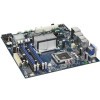- Qualcomm Launches Snapdragon 4 Gen 2 Mobile Platform
- AMD Launches Ryzen PRO 7000 Series Mobile & Desktop Platform
- Intel Launches Sleek Single-Slot Arc Pro A60 Workstation Graphics Card
- NVIDIA Announces Latest Ada Lovelace Additions: GeForce RTX 4060 Ti & RTX 4060
- Maxon Redshift With AMD Radeon GPU Rendering Support Now Available
Intel Desktop Board DG45ID

We’re taking a look at Intel’s first attempt at a full-featured media center motherboard, the DG45ID. It’s also our first look at their new G45 Express chipset, which promises to finally bring DX 10 support and hardware-accelerated HD video playback to their integrated graphics offerings. Can the DG45ID prove itself a worthy choice for your HTPC?
Page 9 – Gaming: Half-Life 2: Episode Two & Call of Duty 4
For real-world game testing, we turn to Valve’s Half-Life 2: Episode Two, which has long been a standard for our game benchmarking. With Episode Two, Valve delivers more of what fans loved about the original Half-Life 2, as well as a few twists, including a level where players pilot a cobbled-together dune buggy through an obstacle course. Driving may seem like a strange addition to what is typically considered a first-person shooter, but the “Riding Shotgun” level we’re using in this testing combines fast-moving scenery with complex AI, which is a perfect test for the capabilities of more modest hardware.
For our testing, we begin by loading the level from the console and initiating the benchmarking run in FRAPS 2.9.4, which is used to collect frame rate data during the test. The vehicle begins the level in exactly the same spot, and follows a well-defined path through the obstacle course to its finish. For detailed information about the settings used in testing, see the screen shots of the ‘settings’ screens on the Testing Methodology page of this article. Again, average and minimum frame rate data is collected, as well as frametime data which is translated to frame-by-frame frame rate data and plotted vs. time below.

We ran into a little trouble when we attempted to benchmark Half-Life 2: Episode Two on the Intel DG45ID motherboard. Okay… a lot of trouble, most of which can probably be blamed on immature video drivers. We experienced an instant game lockup when we attempted to change display modes in the ‘Options’ panel, and the 1680×1050 display mode we usually attempt to test at proved to be so problematic that after working on the issue for weeks with Intel, we finally gave up and settled for 1280×1024.
Intel promises significantly improved 3D performance from the G45’s integrated GMA X4500HD chipset, and that much proved true – while the G35 tottered along at a meager (and unplayable) 9.7 FPS, the G45 chipset on the DG45ID managed to crank out 14 fps – still not where we’d call the game ‘playable’, but still a marked improvement over the G35. We did witness another phenomenon that was troubling, however – the game would occasionally fail to load certain textures, causing certain geometry within the scene to appear as monolithic black objects. Again, this can likely be blamed on the G45’s premature drivers, and not on any flaw in the hardware itself.
Call of Duty 4: Modern Warfare
Activision’s Call of Duty 4: Modern Warfare has been a mainstay of our graphics hardware test suite for quite some time, and its ability to scale well to lower-power GPUs made it a natural choice for our IGP motherboard testing. It’s multi-threaded, and its graphics engine is one of the most efficient in the business.
Our level of choice for graphics testing is “The Bog”, which is an extremely system-intensive level that features spectacular lighting, gunfire, and explosions, as well as fog and night-vision overlays. Our run consists of storming an apartment building and flushing the enemy out of their second-story hiding spot, and ends just as we’re leaving the building – on average, a four-minute scenario. Check out the Testing Methodology page of this article for more details on the settings used.

In sharp contrast to our hair-tearing experience with Half-Life 2: Episode Two, we had no trouble getting Call of Duty 4 to run at a 1680×1050 resolution. However, at that resolution the G45 chipset still couldn’t manage a playable frame rate. Even so, the G45 flexed its comparatively larger graphics muscles and delivered a significantly higher frame rate than the ASUS motherboard’s G35 chipset, again validating Intel’s claims of greatly improved 3D performance.
Let’s wrap up with our final thoughts on the DG45ID on the next page.
Support our efforts! With ad revenue at an all-time low for written websites, we're relying more than ever on reader support to help us continue putting so much effort into this type of content. You can support us by becoming a Patron, or by using our Amazon shopping affiliate links listed through our articles. Thanks for your support!






